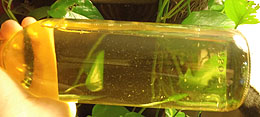 Hi Everyone! I hope you all are staying safe and warm with all this ridiculously cold arctic air that’s been hanging around much of the continental US this winter! All these cold temperatures got me thinking about how you all were handling the extremes in your home, and in particular pertaining to your fermentations and wine storage. Thankfully, we never lost electricity for any reason (not yet anyway), and we have a pretty decent heating system, so my little fermentation is still just happily going along just fine in lower 70s!
Hi Everyone! I hope you all are staying safe and warm with all this ridiculously cold arctic air that’s been hanging around much of the continental US this winter! All these cold temperatures got me thinking about how you all were handling the extremes in your home, and in particular pertaining to your fermentations and wine storage. Thankfully, we never lost electricity for any reason (not yet anyway), and we have a pretty decent heating system, so my little fermentation is still just happily going along just fine in lower 70s!
As far as storage is concerned, I don’t really have any storage space other than the floor of the guest bedroom (seems to be the coolest room in the house). It’s not ideal storage, but let’s be honest, I’m not aging my first batch of wine long enough for it to cause a problem! I’ve got my bottles laying on their sides and they are on the floor where it is coolest.
I wonder how others have been handling their storage conditions in, for example,
freezing cold cellars?
Speaking of waiting for wine to age, it’s kinda like waiting for paint to dry, no? I suppose it has been a little while since I checked in with my first batch of homemade wine (the Pinot Grigio). It’s been a little over a month now since bottling, so I figured now is as good a time as any to check up on her! I did notice that the bottles seem to have little white “specks” that have floated to the bottom, and when agitated, float around in the wine and eventually settle back down. As far as I could guess, this is probably something that naturally occurs if one does not filter the wine, or if the clarification process wasn’t enough? Even though the instructions recommended filtering the wine, I didn’t have the proper wine filtering equipment with me at the time, so mine went unfiltered.
Have any of you noticed this sort of
precipitate in your wine?
Not going to be deterred, I still wanted to try the wine!
On the nose: I still feel like I can smell “plastic”, but I think that could be a bias that I have. What I really need to do is have an unbiased nose smell it to see if what I’m smelling is real, or if I’m just crazy!
When I taste the wine, I was pleasantly surprised with how it has progressed so far. Granted, it’s only been a month so it’s not that different than it was 4 weeks ago, but I have to say it seems a little more round to me, with the citrus fruit notes starting to become more integrated and balanced with the acidity of the wine. Previously, I noted that the wine would be much better with food than alone, but now it’s starting to come in on its own and a teeny bit more complex by itself.
I’m happy with the progress so far, and am looking forward to enjoying more of it!
Cheers!
————————————————————————————————————-
 My name is Leigh Erwin, and I am a brand-spankin’ new home winemaker! E. C. Kraus has asked me to share with you my journey from a first-time dabbler to an accomplished home winemaker. From time to time I’ll be checking in with this blog and reporting my experience with you: the good, bad — and the ugly.
My name is Leigh Erwin, and I am a brand-spankin’ new home winemaker! E. C. Kraus has asked me to share with you my journey from a first-time dabbler to an accomplished home winemaker. From time to time I’ll be checking in with this blog and reporting my experience with you: the good, bad — and the ugly.

I have never filtered any of my wines. If you let it sit in the carboy long enough all that settlement. (I’m going to assume its just left over pectins and tannins) will fall out and the wine can be racked off the top.
There are two ways to clear up any particles from your wine. One is time, just leave your wine in the secondary fermenter until it is clear and siphon it off the sediment. The second is to use a fineing agent, usually included in most kits. For my fruit wines I use a product called, SUPER-KLEER K.C. and I get very clear wines.
I live in MN and am gone in the winter. I turn off the heat in the house and leave during the winter. Does this hurt the storage of the wine or just delay it?
Mike, having the bottled wine chill down during the winter is not a problem. Like you stated, it just extends the aging time. What you don’t want is for the bottle temperature to be on a roller coaster ride. One week 70F, the next week 50F, and the next week 60F. You want temperature fluctuation to be minimal. Having it go up and down once or or twice a year is not a problem it’s when it goes up and down all the time.